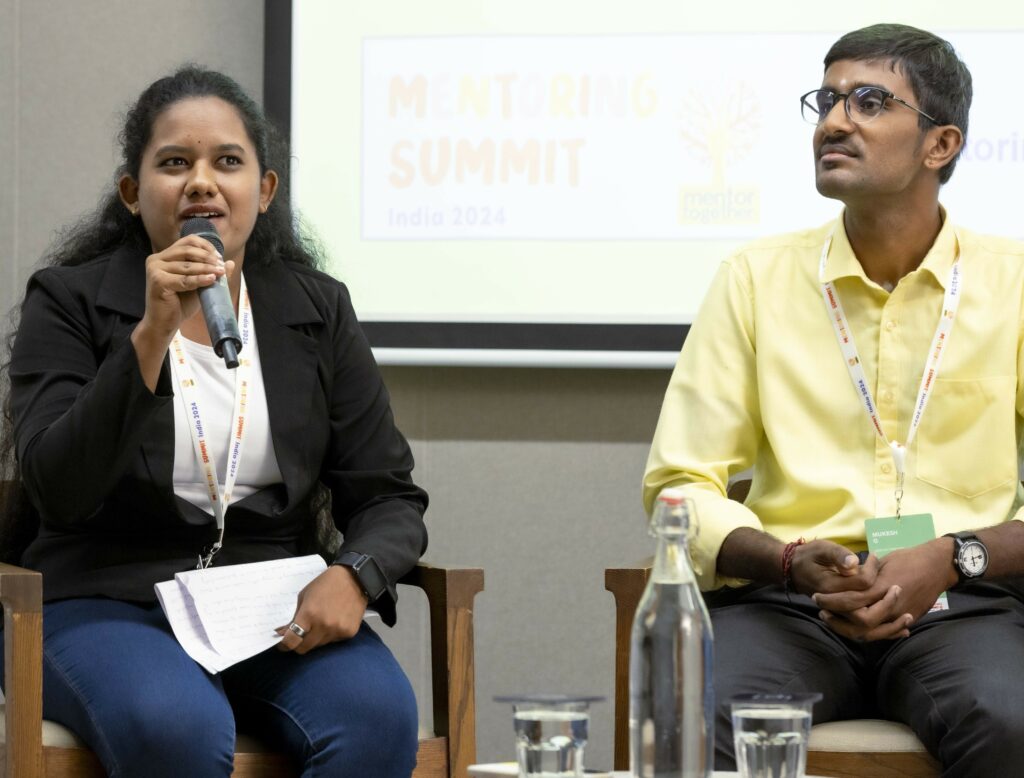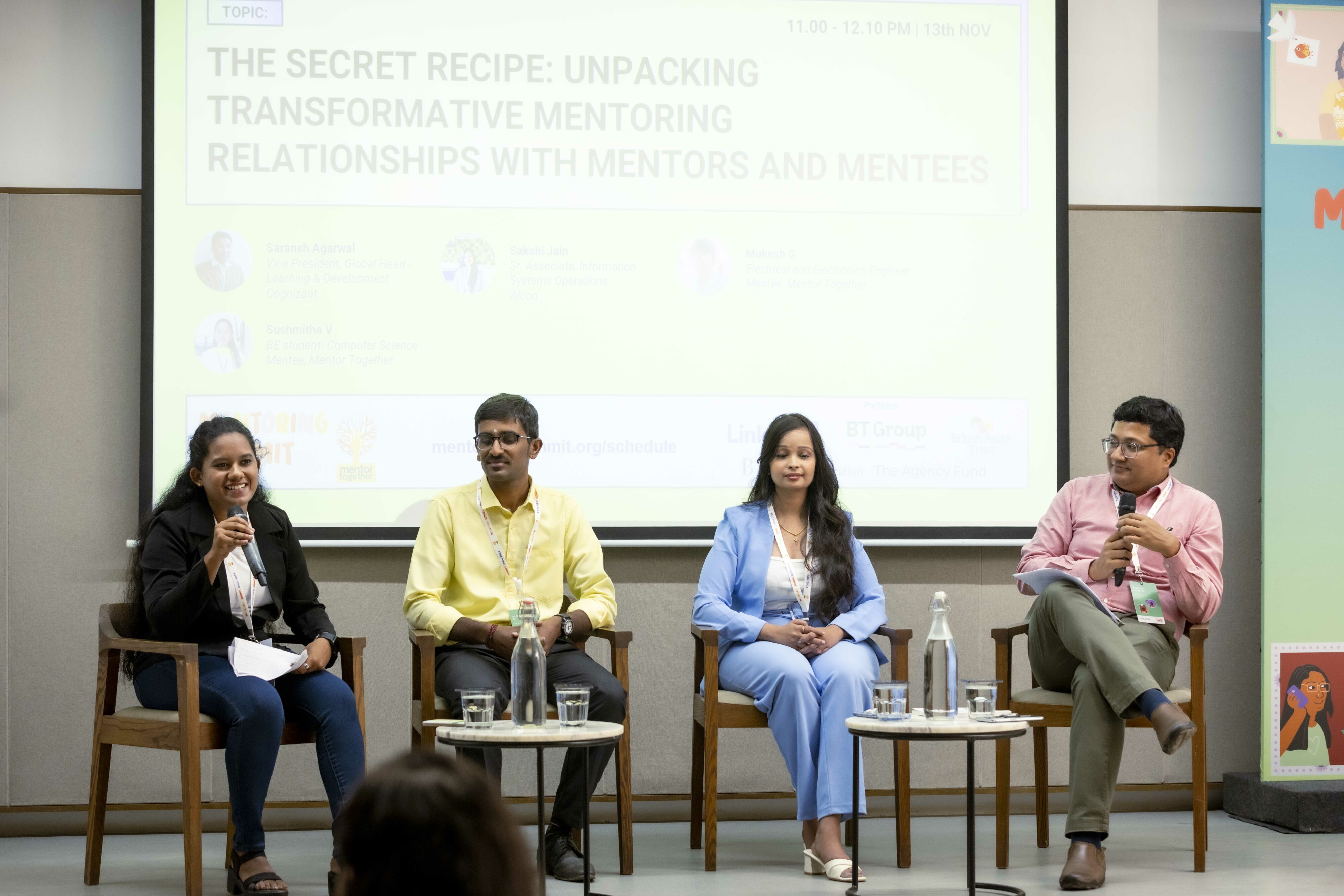
Author
Lauren Carvalho
The Mentoring Summit India 2024 brought forth new perspectives on mentorship. In a particular session, titled ‘The Secret Recipe’, a panel of mentors and mentees unpacked mentoring relationships. Mr. Saransh Agarwal and Ms. Sakshi Jain led the discussion and had two mentees from Mentor Together, Mr. Mukesh G and Ms. Sushmitha V, share their experiences.
Saransh has been a mentor with Mentor Together since 2014, starting in a program in Chennai and then moving to the digital mentoring program in 2019. He has 20+ years of experience spanning different HR streams. He is currently ‘Vice President, Global Head – Learning & Development’ at Cognizant. Sakshi Jain has also been a mentor with Mentor Together for the past six years and supports various NGOs that empower individuals to achieve their dreams. She is a Senior Associate at Alcon.
Mukesh G is a graduate in Electrical and Electronics Engineering from the University Visvesvaraya College of Engineering. He is currently an intern at a startup called MosIC. Sushmitha V is a final-year BE student in Computer Science and Engineering at Sri Krishna Institute of Technology.
Firstly, the speakers discussed the topic of becoming a mentor. How does one feel called to help a student unlock their potential? Sakshi answered this aptly, having been a mentor herself for 6 years. She reflected on her humble beginnings, revealing that she studied at a tier three college. As the job market was extremely competitive, placements were at an all-time low. With limited job prospects and a one-way ticket to Bangalore in hand, she found herself in the silicon valley of India. After landing a job in Wipro, she discovered Mentor Together. They were looking for someone to guide engineering students, and Sakshi felt called to help. The first batch of students she mentored had poor communication skills and their resumes were weak. With Sakshi’s go-getter attitude, she helped them gain confidence by offering sound advice and hearing them out. “Knowing that these students’ lives have completely transformed is the most rewarding aspect of mentoring. If you are in a position to help someone at any point in your life, you must do it and give your 100% to helping that person”, Sakshi says.
Her experiences are similar to what research finds on why people mentor. Many mentors derive their professional identity and a sense of fulfillment from helping a young person establish and succeed in a career of their choosing. There is pride in being able to transform a life, with some mentors even comparing the process to parenting (Wright, 1987).
Saransh, also talked about his introduction to mentoring. With 25 years of experience, he reached a certain point in his career where he wanted to give back and help young professionals reach their goals. After connecting with a supervisor for guidance, he realised that everyone needs a mentor, whether they’re just starting or have already advanced in their careers.

Since mentoring is a two-way relationship, it is essential to see things from a mentee’s perspective as well. Mentee Sushmitha began by remarking that standing on stage was a testament to the benefits of mentoring in her life. Previously an introvert, she had struggled when she joined University to study Computer Science. Mentor Together came to her institution to encourage students to participate in mentoring, and she signed up, not knowing what to expect. In the first few sessions, Sushmitha barely said a word, but eventually grew more comfortable with her mentor, who was patient and encouraged her to voice her thoughts. This shows that mentoring not only impacts one’s studies or career, but also transforms a person into a confident individual.
Mentee Mukesh shared the qualities he looked for in a mentor. He initially joined the programme as it was free of cost. In his case, his mentor spoke Telugu, which happened to be his mother tongue, and this helped the two bond. He felt comfortable enough to speak his mind, since there was no language barrier. Something as simple as a common language was enough to break the ice and help develop a good rapport with his mentor.

Mentoring is not an easy task, as the first time a mentor and mentee connect is essentially a meeting of strangers. In order to create a working alliance and begin a relationship continuum, the mentor must cultivate a safe and comfortable environment. This in turn brings about a sense of trust and confidence to the mentoring relationship, helping the mentee open up and share exactly what’s on their mind. Research has found that creating such an environment makes for meaningful conversations that provide the mentee with new perspective and boost their cognitive skills (Price-Mitchell, 2019).
Sakshi discovered that finding a common hobby between her and her mentees helped in building trust. She rightly pointed out that mentorship does not end with getting your mentee a job. If you have taken someone under your wing, you must be a role model and guide in all aspects of their life. Another way to build trust in a mentoring relationship is to respect each other’s time and be fully present. When a mentor shows genuine interest in their mentee through active listening, the mentee feels understood and heard.
There can also be common misconceptions about mentorship. Many mentees come into mentoring programmes assuming that they are going to participate in a transactional relationship, where the mentor guarantees them a job offer from a top company. However, a mentor is meant more to equip mentees with the skills to land such jobs. A mentor must create a supportive and open environment where mentees feel comfortable sharing their challenges without fear of judgement. Rather than taking on an authoritative role, a good mentor will encourage honesty and self-reflection, helping mentees acknowledge their shortcomings. Such transparency will allow the mentor to assess their mentee’s progress and change their approach, if necessary.
While a mentee grows and achieves their goals, the mentor too learns new things that add value to their leadership skills and careers. Sakshi commented that her communication skills have significantly improved, and whatever advice she gives to her mentees, she first implements in her own life. She also learnt that at times, there may not always be a clear-cut solution to a mentee’s problems. In some situations, all she had to do was listen and see things from her mentee’s perspective. She emphasised the importance of emotions over logic under certain circumstances, saying that prioritising her mentees feelings helped gain their trust.
From his mentoring experiences, Saransh says that he learnt that asking the right questions is important in order to achieve success. Instead of direct instructions to mentees, reflecting on their own questions and interests is much more beneficial. He put it perfectly, “It is important for mentees to have unique learnings and experiences, rather than trying to mimic the path we as their mentors have taken”.
The session illustrated the complexity and benefits of a mentoring relationship – it extends past simply offering solutions or imparting knowledge. The journey is rather about building a steady relationship, creating trust, and achieving long term goals with perseverance. As Sakshi and Saransh pointed out, their goals were achieved when they supported their mentees, while ultimately allowing them to chart their own path to success. Mukesh and Sushmitha are a testament to this fact and their journey shows us that a healthy mentoring relationship truly brings about growth and transformation.
Works cited:
Price-Mitchell, M. (2019, June 19). Youth Mentoring Rocks! How Teens Find Great Mentors. Roots of Action. https://www.rootsofaction.com/youth-mentoring/
Wright, C. A., & Wright, S. D. (1987). The Role of Mentors in the Career Development of Young Professionals. Family Relations, 36(2), 204–208. https://doi.org/10.2307/583955

